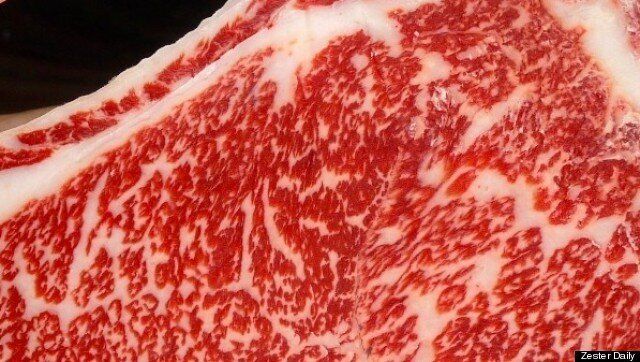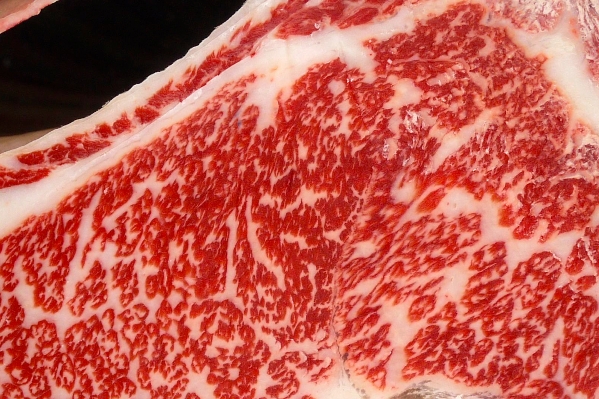

By Clifford A. Wright
Not many people eat a steak they love so much they become a rancher, but, in essence, that's what Robert Estrin did.
In the mid-1990s, Bob and his wife Mary Lloyd Estrin began to operate Lone Mountain Cattle Company in Golden, N.M., raising Angus beef. Then in 2004, Bob, a retired film editor ("The Candidate," "Badlands" and "A River Runs Through It") and former professor at the School of Cinematic Arts at the University of Southern California, who was raised in southeastern New Mexico, tasted Wagyu beef at a Japanese restaurant and that was that.
Soon he and Mary took over Mary's family's cattle ranch and began a fullblood Wagyu breeding program using modern breeding techniques, including artificial insemination and embryo transfer. They wanted Lone Mountain Ranch to become a model of sustainable yet profitable practices.
Their commercial breeding operation pitches other ranchers with the slogan "Take your herd beyond prime with fullblood Wagyu." In 2005, they began with seven cows and two bulls. In 2008, Lone Mountain had its first auction of live cattle and genetics. In 2010 they began selling their beef to the public.
One of the first challenges Bob and Mary faced was confusion from ranchers and the public about Wagyu beef and its relationship to famed Japanese Kobe beef. Wagyu is a breed of Japanese cattle. Kobe is not a breed, but rather a famous beef-producing region in the Hyogo Prefecture of Japan. Wagyu cattle born and bred in the U.S. cannot be labeled Kobe beef -- a process regulated by the Japanese government. Since 2010 trade restrictions have meant no Kobe beef has been imported from Japan to the United States.
The genetics of Wagyu -- semen, embryos, live cattle -- are strictly regulated by the Japanese government and are no longer allowed to be exported. American restaurants sometimes refer to "American-style Kobe" or "100% Kobe," and those terms refer to beef produced in America from a cross between, usually, Wagyu and Angus.
Fullblood Wagyu cattle or beef derived from true 100% Japanese black Wagyu genetics are being produced in small numbers in the United States. These fullblood Wagyu are DNA verified to assure they are from the original Japanese genetics. There is no requirement that fullblood Wagyu be bred, born or raised in Japan, as long as the genetics are DNA verified. So a distinction must be made between true Kobe beef and Wagyu beef from American-style Kobe. To be clear, "American-style Kobe" may refer to many types of Wagyu, even some fullblood, or purebred (98% Wagyu, or even as low as 50% Wagyu). This detail is, of course, not specified on American restaurant menus. True Kobe is 100% fullbood Wagyu, but 100% fullblood Wagyu is not necessarily true Kobe.
Wagyu beef a personal favorite
One taste of Wagyu beef will tell the story of why it is considered special. This is the best tasting steak you can possibly eat, period. It is stratospherically beyond a USDA prime steak diners may eat in a fine steakhouse.
Wagyu beef is so finely marbled with intramuscular fat that its texture and taste is extraordinarily tender and flavorful. Marbling refers to the streaks and specks of fat dispersed in the lean red tissue of the beef, and this is the best indicator of flavor and juiciness. In fact, marbling is one of the USDA's primary ways of grading beef. Wagyu is special because it is the highest marbled breed in the world with, for example, 45% and higher marbling than a USDA Choice grade.
To enhance Wagyu cattle beyond its genetics, Lone Mountain raises Wagyu beef for 28 to 32 months, which is one reason the beef is so expensive. For comparison, the average age of an Angus animal at slaughter is 18 months. Another reason for the high expense is that they are scarce. There are only about 7,000 Wagyu cattle in the U.S. compared to 30 million Angus/black-hided animals. Furthermore, seedstock is very expensive, sometimes more than $7,500 for a fullblood bull when the rancher can find them for sale. Right now there are almost none as everyone is sold out.
How to grill Wagyu to perfection
To cook Wagyu beef, look for the best cut. One cut that shows off the true deliciousness of Wagyu beef is the 1-pound boneless rib eye steak sold by Lone Mountain, a member of the American Wagyu Association.
At $63 a pound, these are steaks you'll want to cook carefully on the grill. Build a blazing hardwood charcoal fire to one side of your grill and wait until every piece is white-ashed and the grate very hot. Bang the coals so the white ash falls off. Place the steaks on the grate directly over the coals so that they rest about 4 inches from the heat source.
RELATED: Tips for a perfectly grilled steak.
Grill on one side without moving the steaks for four minutes. There will be flames, but that's OK. If you're worried, place the cover over the grill to help dampen the flames. Turn the steak and continue cooking for another four minutes uncovered. If you're still worried, move the steak to the cool side of the grill and let cook six minutes.
Take the steak off the grill, season with salt and pepper, and enjoy. If you like your steak cooked medium and beyond you're wasting your money on Wagyu.
Zester Daily contributor Clifford A. Wright won the James Beard / KitchenAid Cookbook of the Year Award and the James Beard Award for the Best Writing on Food in 2000 for "A Mediterranean Feast." His latest book is "Hot & Cheesy" (Wiley) about cooking with cheese.
Also fresh from Zester Daily:
Freshen up with a cool cantaloupe tea daiquiri.
Learn slick knife skills to turn a cucumber into a coiled dragon.
Newcomers to the wine world recount their adventure in "Uncorked."
How Mount Etna's volcanic soil produces Sicily's most unique wines.